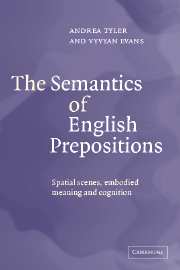Book contents
- Frontmatter
- Content
- Preface
- Acknowledgements
- 1 The nature of meaning
- 2 Embodied meaning and spatial experience
- 3 Towards a model of principled polysemy: spatial scenes and conceptualization
- 4 The semantic network for over
- 5 The vertical axis
- 6 Spatial particles of orientation
- 7 Bounded landmarks
- 8 Conclusion
- References
- Index
6 - Spatial particles of orientation
Published online by Cambridge University Press: 22 September 2009
- Frontmatter
- Content
- Preface
- Acknowledgements
- 1 The nature of meaning
- 2 Embodied meaning and spatial experience
- 3 Towards a model of principled polysemy: spatial scenes and conceptualization
- 4 The semantic network for over
- 5 The vertical axis
- 6 Spatial particles of orientation
- 7 Bounded landmarks
- 8 Conclusion
- References
- Index
Summary
In the previous two chapters we have argued that the semantics of over, under, above and below differentially reference the vertical axis (or what Langacker, 1987, terms ‘oriented space’). As such, these spatial particles serve to partition conceptual space in terms of verticality. In this chapter, we turn to a subset of spatial particles whose semantics crucially involves an additional element, the orientation of either the LM or the TR. We will deal with four forms which relate to an oriented TR: up, down, to and for, and four which relate to an oriented LM: in front of, before, behind and after.
Orientation is a designation of a conceptual front/back, top/bottom, or lateral partitioning of either the TR or the LM. This conceptual partitioning has its basis in a perceived asymmetry of the partitioned entity. Such asymmetry can arise as a result of the way the entity typically stands or sits, its shape (e.g., if an object has a pointed end, it is typically understood as its ‘front’) (Talmy, 2000), its perceived parts (Talmy, 2000), its perceived ‘directedness’ (Talmy, 2000: 199), its movement (Fillmore, 1971), or the way it is used by humans (e.g., the ‘front’ of a building is the side which is accessible for general entry) (Langacker, 1987), as well as its perceived resemblance to human beings or animals (Fillmore, 1971; Herskovits, 1986; Svorou, 1994). Clearly, the attributes which give rise to an object being conceptualized as asymmetric involve how humans both perceive and interact with the object.
Information
- Type
- Chapter
- Information
- The Semantics of English PrepositionsSpatial Scenes, Embodied Meaning, and Cognition, pp. 132 - 177Publisher: Cambridge University PressPrint publication year: 2003
